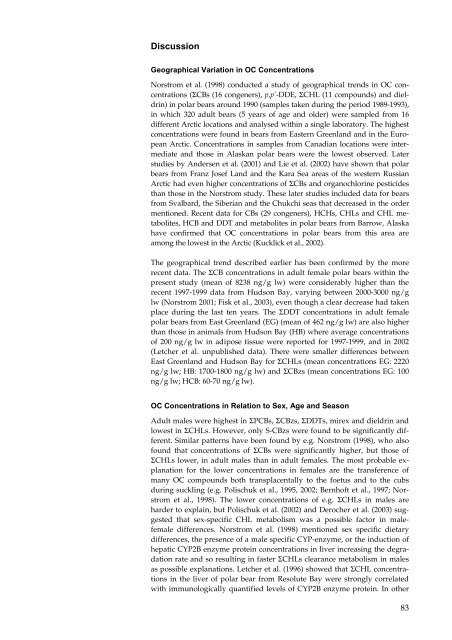Organohalogen concentrations and a gross and histologic ...
Organohalogen concentrations and a gross and histologic ...
Organohalogen concentrations and a gross and histologic ...
You also want an ePaper? Increase the reach of your titles
YUMPU automatically turns print PDFs into web optimized ePapers that Google loves.
Discussion<br />
Geographical Variation in OC Concentrations<br />
Norstrom et al. (1998) conducted a study of geographical trends in OC <strong>concentrations</strong><br />
(ΣCBs (16 congeners), p,p’-DDE, ΣCHL (11 compounds) <strong>and</strong> dieldrin)<br />
in polar bears around 1990 (samples taken during the period 1989-1993),<br />
in which 320 adult bears (5 years of age <strong>and</strong> older) were sampled from 16<br />
different Arctic locations <strong>and</strong> analysed within a single laboratory. The highest<br />
<strong>concentrations</strong> were found in bears from Eastern Greenl<strong>and</strong> <strong>and</strong> in the European<br />
Arctic. Concentrations in samples from Canadian locations were intermediate<br />
<strong>and</strong> those in Alaskan polar bears were the lowest observed. Later<br />
studies by Andersen et al. (2001) <strong>and</strong> Lie et al. (2002) have shown that polar<br />
bears from Franz Josef L<strong>and</strong> <strong>and</strong> the Kara Sea areas of the western Russian<br />
Arctic had even higher <strong>concentrations</strong> of ΣCBs <strong>and</strong> organochlorine pesticides<br />
than those in the Norstrom study. These later studies included data for bears<br />
from Svalbard, the Siberian <strong>and</strong> the Chukchi seas that decreased in the order<br />
mentioned. Recent data for CBs (29 congeners), HCHs, CHLs <strong>and</strong> CHL metabolites,<br />
HCB <strong>and</strong> DDT <strong>and</strong> metabolites in polar bears from Barrow, Alaska<br />
have confirmed that OC <strong>concentrations</strong> in polar bears from this area are<br />
among the lowest in the Arctic (Kucklick et al., 2002).<br />
The geographical trend described earlier has been confirmed by the more<br />
recent data. The ΣCB <strong>concentrations</strong> in adult female polar bears within the<br />
present study (mean of 8238 ng/g lw) were considerably higher than the<br />
recent 1997-1999 data from Hudson Bay, varying between 2000-3000 ng/g<br />
lw (Norstrom 2001; Fisk et al., 2003), even though a clear decrease had taken<br />
place during the last ten years. The ΣDDT <strong>concentrations</strong> in adult female<br />
polar bears from East Greenl<strong>and</strong> (EG) (mean of 462 ng/g lw) are also higher<br />
than those in animals from Hudson Bay (HB) where average <strong>concentrations</strong><br />
of 200 ng/g lw in adipose tissue were reported for 1997-1999, <strong>and</strong> in 2002<br />
(Letcher et al. unpublished data). There were smaller differences between<br />
East Greenl<strong>and</strong> <strong>and</strong> Hudson Bay for ΣCHLs (mean <strong>concentrations</strong> EG: 2220<br />
ng/g lw; HB: 1700-1800 ng/g lw) <strong>and</strong> ΣCBzs (mean <strong>concentrations</strong> EG: 100<br />
ng/g lw; HCB: 60-70 ng/g lw).<br />
OC Concentrations in Relation to Sex, Age <strong>and</strong> Season<br />
Adult males were highest in ΣPCBs, ΣCBzs, ΣDDTs, mirex <strong>and</strong> dieldrin <strong>and</strong><br />
lowest in ΣCHLs. However, only S-CBzs were found to be significantly different.<br />
Similar patterns have been found by e.g. Norstrom (1998), who also<br />
found that <strong>concentrations</strong> of ΣCBs were significantly higher, but those of<br />
ΣCHLs lower, in adult males than in adult females. The most probable explanation<br />
for the lower <strong>concentrations</strong> in females are the transference of<br />
many OC compounds both transplacentally to the foetus <strong>and</strong> to the cubs<br />
during suckling (e.g. Polischuk et al., 1995, 2002; Bernhoft et al., 1997; Norstrom<br />
et al., 1998). The lower <strong>concentrations</strong> of e.g. ΣCHLs in males are<br />
harder to explain, but Polischuk et al. (2002) <strong>and</strong> Derocher et al. (2003) suggested<br />
that sex-specific CHL metabolism was a possible factor in malefemale<br />
differences. Norstrom et al. (1998) mentioned sex specific dietary<br />
differences, the presence of a male specific CYP-enzyme, or the induction of<br />
hepatic CYP2B enzyme protein <strong>concentrations</strong> in liver increasing the degradation<br />
rate <strong>and</strong> so resulting in faster ΣCHLs clearance metabolism in males<br />
as possible explanations. Letcher et al. (1996) showed that ΣCHL <strong>concentrations</strong><br />
in the liver of polar bear from Resolute Bay were strongly correlated<br />
with immunologically quantified levels of CYP2B enzyme protein. In other<br />
83

















